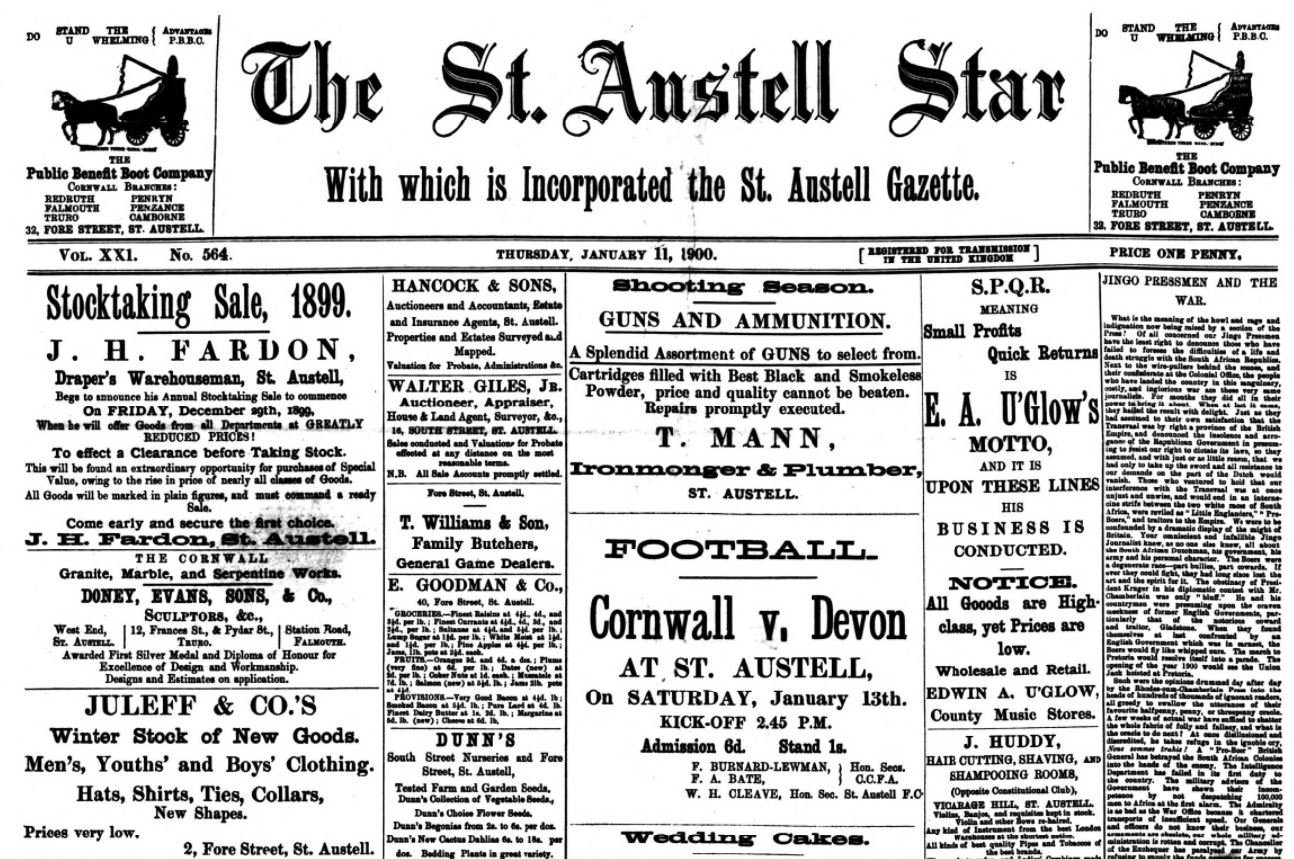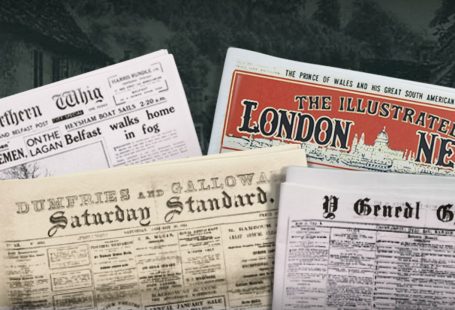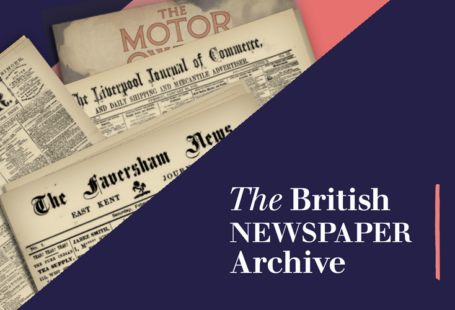This week at The Archive we have added 71,798 brand new pages to our ever growing collection, with a duo of brand new titles joining us this week too, from Cornwall and Buckinghamshire respectively.
So read on to discover more about which new titles we have added, the ten titles we have updated, and also to find out more about the last moments of Mary Pearcey, condemned to death in 1890 for murder.
Register now and explore the Archive
The first new title of the week is the St. Austell Star. First published in one of Cornwall’s largest towns, St. Austell, on 15 March 1889, it could be ‘obtained every Friday in the Towns and Villages throughout Mid-Cornwall’ at the cost of one penny.
The first edition addresses the need for a newspaper in the mid-Cornwall area:
It is with a sense of deep satisfaction and sincere pleasure that we place in the hands of our readers this, the first, number of the ‘St. Austell Star.’ Undoubtedly there is in Mid-Cornwall, and has been for a long time past, a great and deeply felt need of a journal, such as this is intended to be.
St. Austell Star | 11 January 1890
But how would the new publication be run, and how would it exhibit its views? Its debut editorial elaborates:
Believing as we do in outspoken frankness, we shall make no attempt whatever to conceal our principals, nay rather we shall most gladly avow them, as principles of which we are, and are rightly, proud. We shall not attempt to run with the hare and at the same time to follow with the hounds…We shall not profess to be independent of either ecclesiastical or political bias.
Therefore, the St. Austell Star promised to be both an outspoken and principled newspaper, intending to be ‘an essentially Liberal journal,’ but also at the same time ‘earnestly desiring the friendship of those from whom we differ both ecclesiastically and politically.’
St. Austell Star | 17 February 1910
Within the pages of the St. Austell Star, you could find a ‘London Letter’ from the area’s M.P.; at the time of the publication of the first edition this was W.A. McArthur. You could also find illustrations, ‘Election Intelligence’ and ‘Local Intelligence’ from such places as St. Blazey and Mevagissey, as well as the usual local advertisements.
Our second new title of the week is the North Bucks Times and County Observer. Published in Fenny Stratford, a former market town in Buckinghamshire and now part of Milton Keynes, this newspaper was established in 1879 as the Fenny Stratford Weekly Times and General District Advertiser.
Its first edition also lays out the reason for its founding:
In England, in the present days of intellectual advancement, there are few towns of any importance without their own local paper, upon which inhabitants can rely for correct information. Such a paper has long been regarded as a desideratum by the inhabitants of Fenny Stratford. The rapid and still continuing growth of the town appears sufficient to warrant our undertaking and we have every confidence that Fenny Stratford can and will maintain its own representative.
North Bucks Times and County Observer | 28 August 1879
Appearing every Saturday, it was priced at one penny and had a neutral viewpoint. This neutral viewpoint promised to be as inclusive as possible, incorporating all the inhabitants of Fenny Stratford:
Our sympathies are readily to be enlisted by all good works. We can recognise no difference in those who strive to accomplish them. We fearlessly avow that our constituency is not narrowed to the limits of a CLIQUE. Our readers we trust will be found in every class. We shall endeavour to give them the fullest reports of all local events.
Committed to offering accurate reporting, the North Bucks Times contained news from the local towns and villages, including Newport Pagnell, Woburn, Olney, Bletchley, Cranfield and Wavendon. You could also find within its pages the latest news from London, international news (including articles on the ‘State of Russia’ and the ‘Deplorable Condition of Turkey’), and sports results, such as the latest cricket scores.
North Bucks Times and County Advertiser | 10 March 1900
Moving on to our updated titles, of which there are ten this week. We have added over 27,000 pages to neutral North Warwickshire title the Coleshill Chronicle, whilst we have also added new pages to one of our international titles the Civil & Military Gazette (Lahore), the former workplace of poet Rudyard Kipling. Meanwhile, you will also find updates to Northern Irish title the Newry Telegraph and pioneering reforming publication Reynolds’s Newspaper.
You can find full details of all our updates this week at the end of this blog. However, it would be remiss of us not to mention the new pages that we have added to the Illustrated Police News. Founded by London publisher George Purkess in 1864, the Illustrated Police News depicted with lurid joy the unusual, the sensational and the macabre happenings of the day, its front page famous for its graphic depictions of such events.
Illustrated Police News | 12 September 1891
We have added the years 1875 and 1891 to this publication, which contain illustrations like the one featured above, entitled ‘A Thrilling Incident at the Sea-side!’ Luckily, these three women were saved from their perilous situation, which could not be said for the protagonist of our story featured below.
The Last Moments of Mary Pearcey
On 23 December 1890, 24-year-old Mary Pearcey was executed for the murder of her lover’s wife Phoebe Hogg, and her eighteen-month-old child Tiggy. The murdered woman had called upon Mary Pearcey the day that her body was found on a heap of rubbish in Hampstead, 24 October 1890, whilst the body of baby Tiggy was found later, smothered, in Finchley.
Murder victim Phoebe Hogg | Dundee Evening Telegraph | 1 November 1890
Police searched Mary Pearcey’s house, finding blood splatter there, and blood upon a poker and a carving knife. Mary Pearcey claimed she had been killing mice; but she had also been seen pushing Tiggy’s pram around North London and so Pearcey was quickly found guilty and sentenced to death for her crimes.
The Illustrated Police News, a week after her execution in January 1891, contains an account of the condemned murderer’s final days, as well as featuring detailed illustrations of the ‘leading incidents of the ghastly tragedy.’
 Illustrated Police News | 3 January 1891
Illustrated Police News | 3 January 1891
The sensationalist newspaper reports how:
A feeble attempt was made to induce the Home Secretary to advise a reprieve, but it was of no avail. Surely there was never a clearer case against any criminal than that known as the Hampstead Murderer.
But still Mary Pearcey would not admit to her guilt. The Illustrated Police News describes the condemned woman’s final meeting with her solicitor Mr. Freke Palmer, which was conducted in ‘the chief warder’s room’ instead of the ‘ordinary visiting cage’ at Newgate, due to the severity of the winter weather.
Mary Pearcey on trial at the Old Bailey | Penny Illustrated Paper | 6 December 1890
Mary Pearcey entered the room ‘with a firm step and a certain amount of cheerfulness, remarking on the disagreeable weather.’ She asked the solicitor to distribute ‘certain of her articles and trinkets,’ the trinkets being of ‘very small value,’ the newspaper assures its readers. After asking Mr. Freke Palmer to place a cryptic advertisement in the Madrid newspapers – ‘Have not betrayed’ – the solicitor was keen to learn more from Mary about the crime for which she had been condemned:
‘Do you admit the justice of the sentence?’ ‘No,’ was the reply; ‘I do not. I know nothing about the crime.’ ‘But,’ it was urged, ‘even if you did it in a trance you must have some idea or shadowy recollection of the matter?’ ‘I know nothing about it,’ she repeated.
Soon after, Mary Pearcey left and ‘went across the yard to her cell.’
Mary Pearcey in the dock | Penny Illustrated Paper | 22 November 1890
But she was not yet done, ‘one of the last acts of Mrs Pearcey’ being to vindicate the victim’s husband, Mr. Frank Hogg. Having tried and failed to get her former lover to visit her in Newgate (him reportedly being out of London and ‘too far away to be able to get back in time to keep the appointment’), she wrote a long letter to his sister Clara, declaring his innocence:
As I know your brother Frank did not have anything to do with that dreadful crime – I mean the death of his wife or her child, I want the world to know, when I am gone out of it, what I have to say. As I hope for pardon as a sinner before my God I say he (Frank Hogg) did not have anything to do with it, nor did he know anything about it. What I write here is the truth, as I hope to be forgiven by our SAVIOUR.
Imagined last moments of Mary Pearcey | Illustrated London News | 3 January 1891
Although full of praise for Frank Hogg, she did not have any kind words to say about Phoebe, the woman she killed:
Let the world say what they will – I mean the people in it – Frank was a good husband to his wife, and would have been a better one if she had only been a good wife, and stayed at home and looked after him as a wife should have done, instead of being out when he came home, and having nothing ready for him. Dear C., you lived in the same house, and know I am speaking the truth. Where is there a man that would stand such a life? But you know Frank did, and not complain about her.
Indeed, it seemed that Clara was inclined to view Mary Pearcey as not guilty – having written to the condemned woman that ‘she could not believe that the prisoner could be guilty of the crime.’
But that did not matter, and Mary Eleanor Pearcey’s execution was carried out on 23 December 1890. She hoped in her final words to Clara to meet her again ‘in a better land than this one,’ signing herself off as a ‘great sinner.’
After her execution, Madam Tussards created a famous waxwork of her, purchasing objects from Mary Pearcey’s kitchen as well as Tiggy’s pram. The notoriety of the case, no doubt fuelled by such articles from the Illustrated Police News, drew 30,000 people to this morbid exhibition.
New Titles
Title |
Years Added |
| St. Austell Star | 1889-1895, 1898-1911, 1913-1915 |
| North Bucks Times and County Observer | 1879-1895, 1898, 1900-1918 |
Updated Titles
This week we have updated ten of our existing titles.
You can learn more about each of the titles we add to every week by clicking on their names. On each paper’s title page, you can read a FREE sample issue, learn more about our current holdings, and our plans for digitisation.
Title |
Years Added |
| Civil & Military Gazette (Lahore) | 1886 |
| Coleshill Chronicle | 1901-1910, 1950, 1952-1980 |
| Manchester Evening News | 1951 |
| South Eastern Gazette | 1866-1869, 1877, 1889 |
| Newry Telegraph | 1901 |
| Reynolds’s Newspaper | 1930-1932 |
| Leicester Chronicle | 1918, 1920, 1922 |
| Luton Times and Advertiser | 1885, 1892-1893 |
| Retford and Worksop Herald and North Notts Advertiser | 1891-1892, 1903 |
| Illustrated Police News | 1875, 1891 |
You can keep up to date with all the latest additions by visiting the recently added page. You can even look ahead to see what we’re going to add tomorrow.















